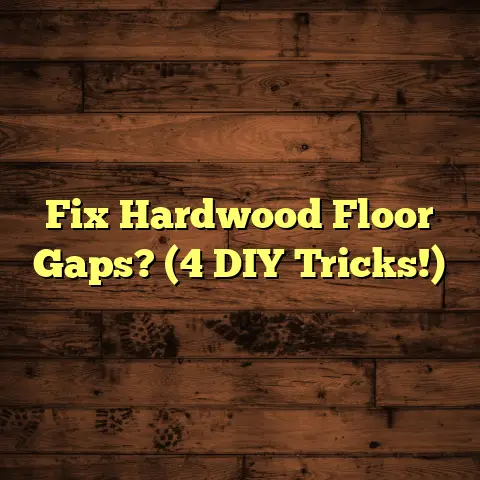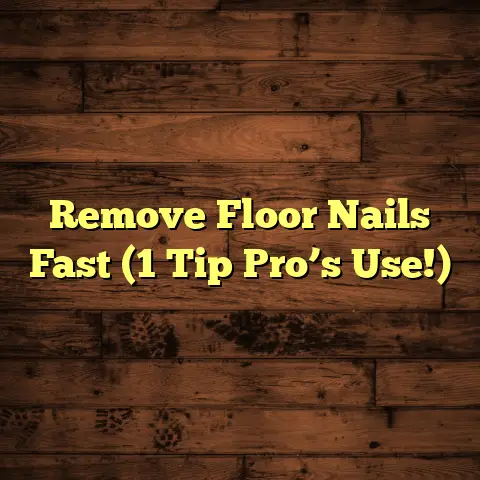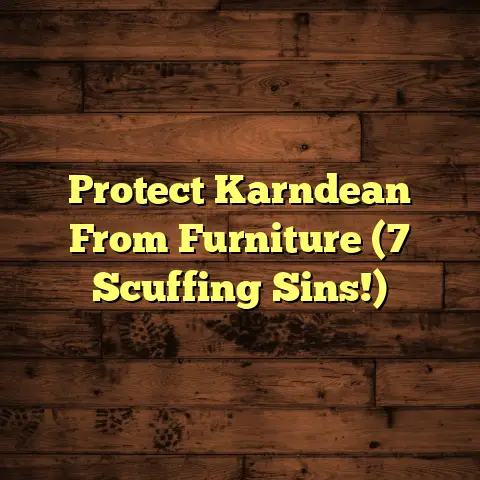Deep Clean Hardwood Floors: DIY Tips? (3 Pro Secrets!)
I’m excited to dive into a topic close to my heart (and my knees, after years of flooring work!): deep cleaning hardwood floors.
It’s amazing how much innovation we’ve seen in cleaning technology. From advanced floor cleaners to robotic vacuums, keeping our hardwood floors looking pristine has become easier than ever.
But let’s be real, sometimes, even with the best gadgets, you need a little extra know-how.
That’s where I come in.
I’ve spent years working with hardwood floors, and I’m going to share my top three “pro secrets” for deep cleaning them yourself.
We’ll also talk about the importance of regular cleaning and how to keep your floors looking their best for years to come.
Ready to get started? Let’s get to it!
Section 1: Understanding Hardwood Floors
1.1 Types of Hardwood Flooring
Okay, before we start slinging mops, let’s talk about the different types of hardwood floors you might have in your home.
There are two main categories:
-
Solid Hardwood: This is the real deal, made from a single piece of wood. It’s durable and can be refinished multiple times.
-
Engineered Hardwood: This is made of layers of plywood with a hardwood veneer on top. It’s more stable than solid hardwood and less prone to warping in humid environments.
Now, why does this matter for cleaning?
Well, engineered hardwood often has a thinner veneer, so you need to be a bit gentler with it.
Solid hardwood can usually handle more aggressive cleaning methods, but you still want to be careful.
Each type presents unique cleaning challenges.
For example, solid hardwood might be more prone to water damage if not sealed properly.
Engineered hardwood, on the other hand, might show scratches more easily due to the thinner veneer.
1.2 Importance of Regular Cleaning
Think of your hardwood floors as an investment. Like any investment, they need to be protected.
Dirt, grime, and even tiny particles of sand can act like sandpaper, slowly wearing down the finish on your floors.
Trust me, I’ve seen it happen.
Regular cleaning prevents this damage and keeps your floors looking their best.
But deep cleaning takes it a step further.
It removes embedded dirt and buildup that regular cleaning might miss.
This not only improves the appearance of your floors but also extends their lifespan.
Think of it this way:
Regular cleaning is like brushing your teeth, while deep cleaning is like going to the dentist for a professional cleaning.
Both are important for long-term health and beauty.
Section 2: Preparing for a Deep Clean
2.1 Assessing Your Floors
Before you start scrubbing, take a good look at your floors. What condition are they in?
Are there any noticeable scratches, dents, or areas where the finish is worn?
Are there any sticky spots or areas with stubborn dirt buildup?
Signs that indicate a need for deep cleaning include:
- Dull or hazy appearance
- Visible dirt and grime buildup
- Sticky or tacky spots
- Scratches and scuffs
If your floors are in pretty good shape, a regular cleaning might be all you need.
But if they’re looking a little worse for wear, it’s time for a deep clean.
Knowing the condition of your floors will help you choose the right cleaning methods and products.
2.2 Gathering Supplies
Alright, let’s get our toolkit ready. Here’s a list of essential supplies for deep cleaning hardwood floors:
- Vacuum: With a soft brush attachment.
- Mop: Microfiber or spray mop.
- Hardwood Floor Cleaner: Choose a pH-neutral cleaner specifically designed for hardwood floors.
- Microfiber Cloths: For wiping up spills and applying cleaner.
- Buckets: One for clean water and one for your cleaning solution.
- Optional: Knee pads (your knees will thank you!).
I am always on the lookout for innovative products that can simplify the cleaning process.
Here are a few of my favorites:
-
Robotic Vacuum: These little guys can help keep your floors clean between deep cleanings.
-
Spray Mop: These mops have a built-in spray bottle, making it easy to apply cleaner as you mop.
-
Hardwood Floor Cleaning Kit: These kits usually include everything you need to clean your floors, including a cleaner, mop, and microfiber cloths.
Section 3: Pro Secret #1 – The Power of Vacuuming
3.1 Why Vacuuming is Essential
Okay, this might seem obvious, but trust me, vacuuming is the most important step in deep cleaning your hardwood floors.
Why? Because it removes all the loose dirt, dust, and debris that can scratch your floors when you start mopping.
Think of it like this:
If you try to mop a dirty floor, you’re just smearing the dirt around and grinding it into the finish.
Vacuuming first removes all that abrasive material, allowing you to clean the floor without damaging it.
3.2 Choosing the Right Vacuum
Not all vacuums are created equal when it comes to hardwood floors.
You want to choose a vacuum with a soft brush attachment.
This will prevent scratching and damage to your floors.
Avoid vacuums with beater bars, as these can be too aggressive for hardwood.
Some vacuum models specifically designed for hardwood floors include:
-
Dyson V-Series: Cordless, lightweight, and powerful with a soft roller cleaner head.
-
Bissell Zing Bagless Canister Vacuum: Lightweight and affordable with a multi-surface floor nozzle.
-
Shark Navigator Lift-Away Professional: Upright vacuum with a brushroll shutoff feature for hardwood floors.
3.3 Vacuuming Techniques
Alright, let’s talk technique.
Here are some tips for effective vacuuming:
-
Use the Right Attachment: Attach the soft brush attachment to your vacuum.
-
Vacuum in the Direction of the Wood Grain: This will help to pick up dirt and debris that may be trapped in the grooves of the wood.
-
Use Overlapping Strokes: Make sure to overlap your strokes slightly to ensure that you’re covering the entire floor.
-
Pay Attention to Edges and Corners: Use the crevice tool to get into hard-to-reach areas.
-
Empty the Vacuum Regularly: A full vacuum can lose suction, making it less effective.
Bonus Tip: Consider using a robotic vacuum to keep your floors clean between deep cleanings.
These little guys can be programmed to vacuum your floors on a regular schedule, saving you time and effort.
Section 4: Pro Secret #2 – The Art of Mopping
4.1 Selecting the Best Mop
Okay, now that we’ve vacuumed, it’s time to mop.
But not all mops are created equal.
Here are a few types of mops that are suitable for hardwood cleaning:
-
Microfiber Mop: These mops are made of soft, absorbent microfiber material that won’t scratch your floors.
-
Spray Mop: These mops have a built-in spray bottle, making it easy to apply cleaner as you mop.
-
Sponge Mop: These mops can be used on hardwood floors, but you need to make sure they’re not too wet.
I personally prefer microfiber mops because they’re gentle on hardwood floors and can be easily washed and reused.
4.2 DIY Cleaning Solutions
Now, let’s talk about cleaning solutions.
You can buy commercial hardwood floor cleaners, but you can also make your own eco-friendly cleaning solutions at home.
Here are a few recipes:
-
Vinegar and Water: Mix 1/2 cup of white vinegar with 1 gallon of warm water. This solution is great for removing dirt and grime.
-
Olive Oil and Vinegar: Mix 1/4 cup of olive oil, 1/2 cup of white vinegar, and 1 gallon of warm water. This solution is great for polishing and restoring shine to your floors.
-
Baking Soda and Water: Make a paste of baking soda and water. Apply to stubborn stains and let sit for a few minutes before wiping clean.
The benefits of using natural ingredients include:
-
Eco-Friendly: Natural ingredients are biodegradable and won’t harm the environment.
-
Safe for Kids and Pets: Natural ingredients are non-toxic and won’t pose a health risk to your family.
-
Affordable: Natural ingredients are often cheaper than commercial cleaning products.
4.3 Mopping Techniques
Alright, let’s get mopping!
Here’s a step-by-step guide on the best mopping techniques to avoid damage to your hardwood floors:
-
Damp Mop, Not Wet Mop: Wring out your mop thoroughly so that it’s damp, not wet. Excess water can damage hardwood floors.
-
Mop in the Direction of the Wood Grain: This will help to prevent streaks and ensure that you’re cleaning the floor evenly.
-
Use Overlapping Strokes: Overlap your strokes slightly to ensure that you’re covering the entire floor.
-
Rinse Your Mop Regularly: Rinse your mop in clean water after each stroke to remove dirt and grime.
-
Dry the Floor Immediately: Use a clean, dry microfiber cloth to dry the floor immediately after mopping. This will prevent water spots and damage to the finish.
Bonus Tip: Consider using two buckets – one for clean water and one for your cleaning solution.
This will help to keep your cleaning solution clean and prevent you from spreading dirt and grime around your floors.
Section 5: Pro Secret #3 – Refinishing and Restoring
5.1 When to Refinish
Sometimes, deep cleaning just isn’t enough.
If your floors have significant scratches, dents, or areas where the finish is worn, it might be time to refinish them.
Indicators that suggest refinishing is necessary include:
- Deep scratches and gouges
- Worn finish
- Discoloration
- Water damage
Refinishing involves sanding down the old finish and applying a new one.
This can restore your floors to their original beauty and protect them from further damage.
5.2 DIY Refinishing Techniques
Refinishing hardwood floors can be a challenging project, but it’s definitely doable if you’re handy and have the right tools.
Here’s a step-by-step guide on how to refinish hardwood floors:
-
Prepare the Room: Remove all furniture and cover any areas you don’t want to get dusty.
-
Sand the Floors: Use a drum sander to sand down the old finish. Start with a coarse grit sandpaper and gradually move to a finer grit.
-
Clean the Floors: Vacuum up all the sanding dust and wipe the floors down with a tack cloth.
-
Apply Stain (Optional): If you want to change the color of your floors, apply a stain according to the manufacturer’s instructions.
-
Apply Finish: Apply several coats of polyurethane finish, allowing each coat to dry completely before applying the next.
-
Let it Cure: Allow the finish to cure for at least 72 hours before walking on the floors.
Important Note: Refinishing hardwood floors can be a messy and time-consuming project.
If you’re not comfortable doing it yourself, it’s best to hire a professional.
5.3 Maintenance Post-Refinishing
Once you’ve refinished your floors, it’s important to maintain them properly to keep them looking their best.
Here are a few tips:
-
Use Rugs in High-Traffic Areas: Place rugs in areas that get a lot of foot traffic to protect the finish.
-
Use Furniture Pads: Place furniture pads under the legs of your furniture to prevent scratches and dents.
-
Clean Regularly: Sweep or vacuum your floors regularly to remove dirt and debris.
-
Avoid Harsh Chemicals: Use a pH-neutral cleaner specifically designed for hardwood floors.
-
Reapply Finish as Needed: Depending on the amount of traffic your floors get, you may need to reapply finish every few years.
Section 6: Additional Tips for Long-Lasting Hardwood Floors
6.1 Preventative Strategies
Prevention is always better than cure.
Here are some preventative strategies to keep your hardwood floors looking their best:
-
Place Rugs in High-Traffic Areas: As mentioned before, rugs can protect your floors from wear and tear.
-
Use Furniture Pads: Furniture pads can prevent scratches and dents.
-
Wipe Up Spills Immediately: Spills can damage the finish on your floors if left untreated.
-
Avoid Wearing Shoes Indoors: Shoes can track in dirt and debris that can scratch your floors.
-
Control Humidity: High humidity can cause hardwood floors to warp and buckle.
6.2 Seasonal Cleaning Routines
Creating a seasonal cleaning routine can help you keep your hardwood floors in top shape year-round.
Here’s a suggested schedule:
-
Spring: Deep clean your floors to remove winter grime and dirt.
-
Summer: Focus on regular cleaning to remove sand and dirt tracked in from outdoors.
-
Fall: Deep clean your floors again to prepare them for the winter months.
-
Winter: Focus on preventing water damage from snow and ice.
Bonus Tip: Consider using a humidifier in the winter to prevent your hardwood floors from drying out and cracking.
Conclusion
So, there you have it – my top three pro secrets for deep cleaning hardwood floors!
I hope you found these tips helpful.
Remember, innovation in cleaning hardwood floors is constantly evolving.
By adopting these DIY tips and pro secrets, you can empower yourself to take control of your cleaning routines and ensure that your hardwood floors remain beautiful and resilient for years to come.
Embrace these methods and enjoy the satisfaction that comes from maintaining your own home.
Happy cleaning!





